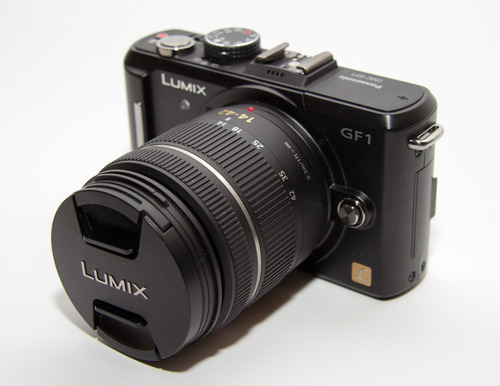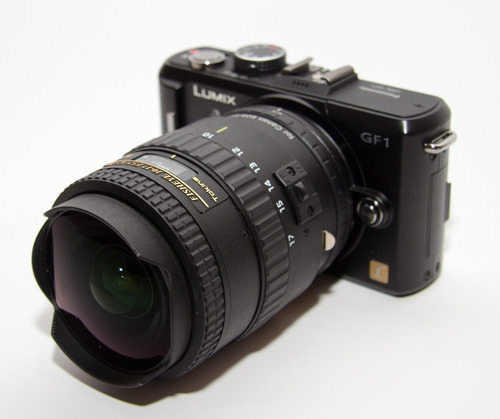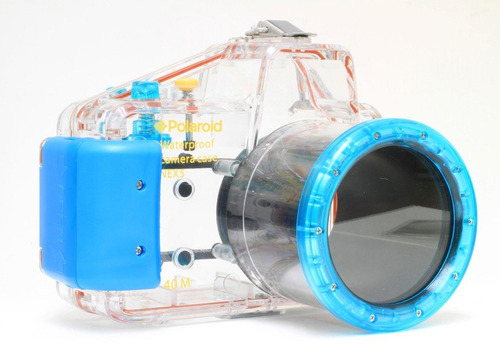I recently bought a second hand Panasonic GF1 body, it’s a Compact System Camera (CSC) which uses the Micro Four Thirds (M43) lens system. The used but well looked after body, boxed with charger etc. cost me less than £100 on Ebay.

I’ll go into more detail about this particular camera another time (in short – I love it). This post is on the more general topic of CSC water photography, specifically why I think they are the future of water based surf photography.
Disadvantages/Barriers
Some of these are things which will definitely not be a problem for long, they are barriers, then there’s some true disadvantages which are unavoidable but which can be overcome
- Smaller sensor – low light performance suffers with a smaller sensor, and it introduces a crop factor, e.g. with my M43 GF1 a 14mm lens is equivalent to a 28mm lens on a 35mm or full frame camera body, this means to get wide angle shots you need a very wide lens.
- Availability of (native mount) lenses – this is improving all the time and there’s already a bunch of good lenses available (coming soon – the CSC surf photography gear wish list).
- Don’t look “professional” – as I mentioned in my review of the Canon 70-200mm L lens, I think this could be an advantage or a disadvantage depending on the situation.
- No Off the shelf surf housings available… yet. I’m sure this will change soon, but as of yet you can’t buy an Aquatech NEX 5, OMD or GH3 housing.
- Slower burst rates – this is not an issue with the newer top end bodies like the Olympus OMD or Sony NEX 5N, but will be if you’ve got an older or more entry level body.
- Lower resolution – the resolution of CSC cameras tops out at 17MP, which is high enough for most uses but might be an issue if you’re used to super high DSLR resolutions, the GF1 is 12MP which is ample for what I use it for.
Advantages/Solutions

Here’s my GF1 with an adapter and the Canon fit Tokina 10-17mm fisheye, it’s not as wide as it is on my 60D, but it works pretty well, I am on the look out for a second hand Samyang 7.5mm fisheye which looks like a great option for M43 camera owners.
- The most obvious advantage is the size and weight, they are all less hefty than any DSLR, but especially the traditional water photographers choice of the Canon 7D.
- Adapters for lenses – you can get cheap adapters for pretty much any type of lens for all of the CSC systems
- Cheaper – the body and lenses are considerably cheaper than the fill size equivalent, you can get a full range of lenses and a top end body for much less than a DSLR set up.
- Will fit into pretty much any existing housing – as they’re smaller you can adapt pretty much any existing housing to fit a CSC set up, a great option until there’s a dedicated option.
- Great at Video – perhaps not that relevant to this blog, but it’s the main reason I bought one, they are generally more flexible in terms of format and are designed with video in mind more than most DSLR’s.
Why not shoot in the water with a CSC?
Right now the biggest barrier to me getting my GF1 in the water is the stupid remote shutter release system they put on it, it uses the same 2.5mm jack plug connector as my Canon 60D but the circuit involves resistors and stuff making it a lot harder than simply plugging my pistol grip into the camera, I’m working on an adapter but it’s taking a while as it involves soldering and some trial and error.
You can buy a basic housing for the NEX 5 for about £100, for that price I would be buying one right now, you need a different housing for each lens and I can’t see one with a dome port yet, but that’s half the price of just a port for my Aquatech housing, it’s not got a pistol grip but there’s a tripod screw on the bottom of it so a DIY option is do-able.
If I was advising someone on what kit to buy today to get into surf photography (especially water photography) on a budget this would be it:
Sony NEX5 with 18-55mm kit lens: £430
Walimex 8mm fisheye for Sony E-mount – £307
Sony High Zoom 55-210mm E-Mount Lens – £246

That’s a pretty decent set up for not much money, I’ve got a similar choice of lenses and resolution from my kit that cost roughly the same but it was all second hand or refurbished, if you got this lot second hand it would be a fraction of the price of my gear and you could definitely be shooting comparable images in no time.
Conclusion
I predict that within a couple of years most surf photographers will have a full frame DSLR body for land stuff and a CSC based water set-up, personally I’m loving the GF1 and will be thinking hard about the next camera body I buy, there’s a good chance my 60D and Canon glass will be traded in for a compact system.
Leave a Reply